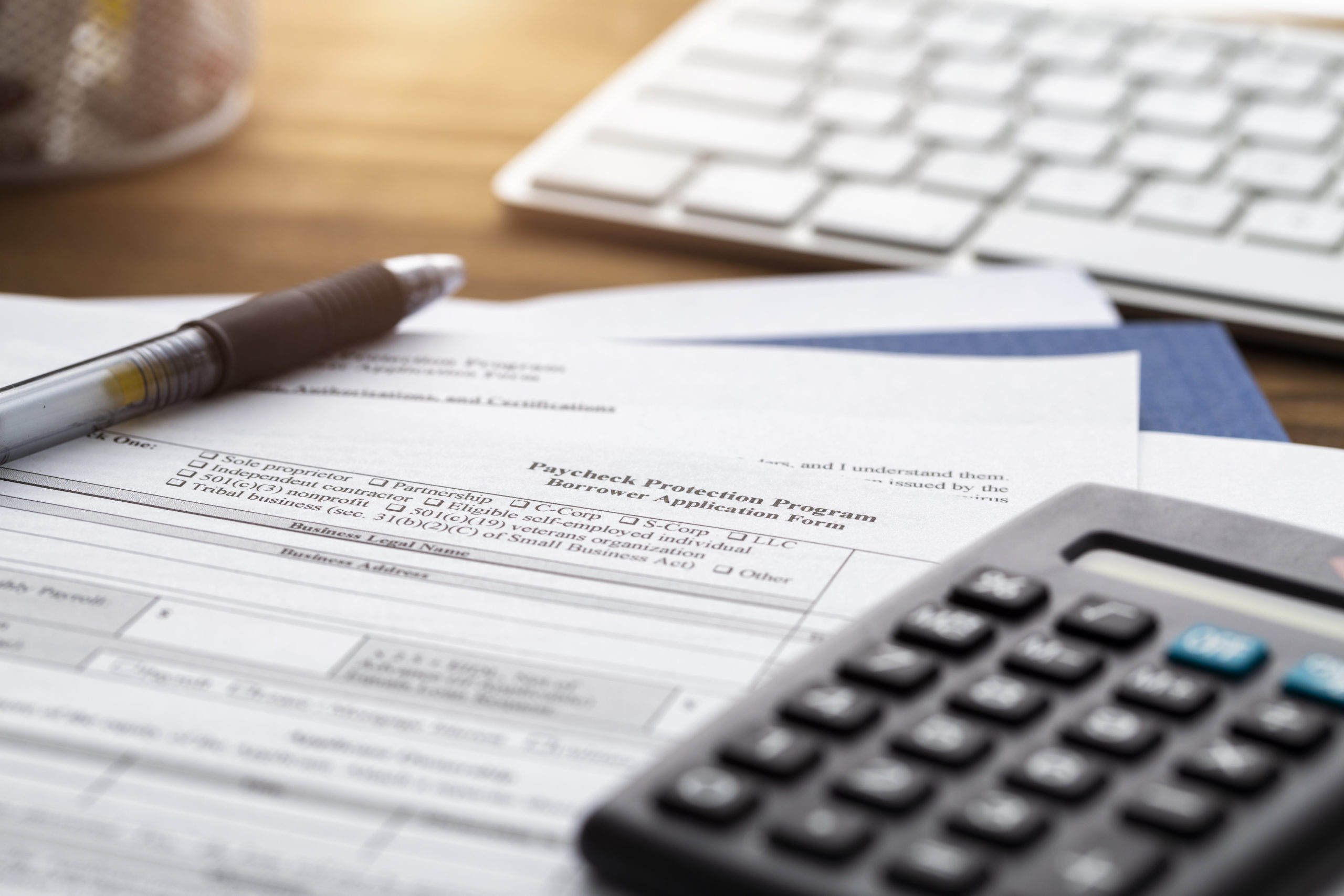Further Guidance Concerning Forgiveness of Paycheck Protection Program Loans

This article was original published on March 31, 2020, and most recently updated on July 6, 2020, to reflect legislative changes and guidance. President Trump recently signed legislation extending the deadline to apply for Paycheck Protection Program loans from June 30, 2020, until August 8, 2020. However, this article will focus on the rules and requirements concerning loan forgiveness.
On March 27, 2020, President Trump signed the Coronavirus Aid, Relief, and Economic Security (CARES) Act into law. Among several financial stimulus provisions, the CARES Act allocated $349 billion to the Paycheck Protection Program (PPP) with the goal of providing loans to small businesses. Less than one month later, on April 21, 2020, the Paycheck Protection Program and Healthcare Enhancement Act allocated an additional $310 billion to the PPP. Then again on June 5, 2020, the President signed the Paycheck Protection Flexibility Act of 2020 (Flexibility Act), amending several provisions of the CARES Act. Since the passage of the CARES Act, guidance has come in the form of an ever-evolving FAQ document and various interim rules, interpretations, and amendments as published by the U.S. Department of the Treasury (Treasury). The most recent guidance was issued as recently as June 25, 2020. This update accounts for changes to the PPP through July 6, 2020.
PPP loans are administered by the Small Business Administration (SBA). The loans are originated by authorized third-party SBA 7(a) lenders. Eligible participants can borrow up to $10 million based on payroll amounts at a fixed rate of 1% for either a two-year or five-year term.1 Permissible uses of PPP loan proceeds include payments for qualified payroll costs, employee benefits, healthcare costs, mortgage interest, rent and utilities, and interest on pre-existing debt obligations. The proceeds must be used on those eligible costs during the period starting on the date the PPP loan is funded and ending on the earlier of: (i) December 31, 2020; or (ii) 24 weeks following the funding date (Covered Period). However, a borrower that received loan proceeds before June 5, 2020, may elect to use the original 8-week covered period. For payroll costs only, for either the 8-week or 24-week period, a borrower may elect to use the first pay period following the loan funding date (Alternative Covered Period).
If the loans are used for these qualifying purposes, and other appropriate conditions are met, all or a portion of the principal balance can be forgiven.
The PPP rules are complicated and are fact-intensive to each particular borrower’s set of circumstances. Therefore, we recommend that a borrower with questions seek out the advice of a professional.
What are authorized expenses of PPP loan proceeds?
PPP loans can be used to cover the following business expenses:
- qualified payroll costs;
- costs related to the continuation of group health benefits during periods of paid sick, medical, or family leave, and insurance premiums;
- mortgage interest payments (prepayments and principal payments are not eligible);
- rent payments;
- interest on debt obligations incurred prior to February 15, 2020;
- utility payments; and
- refinancing an SBA Economic Injury Disaster Loan (EIDL) made between January 31, 2020, and April 3, 2020.
For a business, “payroll costs” are any compensation to employees in the following forms:
- salaries, wages, commissions, or similar compensation (capped at $100,000 per employee);
- payments of group health coverage insurance premiums, retirement benefits, and state and local employment taxes;
- cash tips or the equivalent;
- payments for parental, vacation, family, sick, or medical leave; and
- severance/separation payments.
For a sole proprietor, “payroll costs” consist of wages, commissions, income, or net earnings from self-employment or similar compensation.
Please note that the employer side of federal taxes imposed on employee compensation is excluded from payroll costs. Also, as explained below, the scope of forgivable expenses is more narrow than eligible expenses.
Funds cannot be used for compensation of employees, independent contractors, or sole proprietors in excess of an annual salary of $100,000 (on a prorated basis), for compensation of employees residing outside of the United States, for certain other taxes imposed under the Internal Revenue Code of 1986, as amended, or for paid leave wages covered by the Families First Coronavirus Response Act.
What steps can be taken to maximize loan forgiveness?
Up to the full amount of the loan and accrued interest can be forgiven, provided the borrower satisfies the head count and salary maintenance provisions.
The actual amount of the loan eligible for forgiveness will depend upon the total amount of: (i) payroll costs; (ii) payments of interest on mortgage obligations incurred before February 15, 2020; (iii) rent payments on leases dated before February 15, 2020; and (iv) utility payments for services that began prior to February 15, 2020, incurred and paid during the loan forgiveness covered period (8 weeks or 24 weeks, depending on the covered period which applies, from the date of loan issuance).
The prorated eligible cash compensation over the covered period are as follows:
- 8-week covered period – $15,385 per employee/owner;
- 24-week covered period – $46,154 per employee; and
- 24-week covered period – lesser of $20,833 or 2.5 months of net profit (owner compensation replacement amount).
A borrower that receives a PPP loan before June 5, 2020, has the option to choose either the 8-week or 24-week covered period.
For forgiveness purposes, at least 60% of the loan proceeds must be used for payroll costs. This requirement will be interpreted “as a proportional limit on non-payroll costs as a share of the borrower’s loan forgiveness.”2 This clarifies that if less than 60% of proceeds are used for payroll costs that the amount eligible for forgiveness will only be reduced, not totally eliminated. For example, if a borrower receives a $100,000 loan, and during the covered period spends $54,000 (54%) of the loan proceeds on payroll costs, then because less than 60% was used on payroll costs, the maximum amount of loan forgiveness is $90,000 ($54,000 in payroll costs constituting 60% of the forgiveness amount and $36,000 in non-payroll costs equaling 40% of the forgiveness amount).
After establishing the gross loan amount eligible for forgiveness, it can be reduced by: (1) a reduction in the number of full-time equivalent employees (FTE); or (2) reduction in pay for employees earning under $100,000 per year.
The calculations and rules describing the FTE and salary maintenance rules are outside the scope of this article. However, the Flexibility Act included a rehire safe harbor that will not cause a reduction in forgiveness for FTE purposes if a borrower can, in good faith, do one of the following:
- document the inability to rehire individuals who were employed on February 15, 2020;
- document the inability to hire similarly qualified employees for unfilled positions on or before December 31, 2020; or
- document that adhering to safety, sanitation, and social distancing orders by the CDC, OSHA, or Health and Human Services, for customers or workers, prevented a return to the same level of business activity that existed as of February 15, 2020.
Finally, we suggest that the borrower take the following steps that may help with the loan forgiveness application:
- depositing all PPP loan funds into a separate bank account;
- keeping all documents reflecting how the PPP funds were used; and
- having documentation that verifies the number of FTE employees on payroll and their pay rates during the covered period, including (i) payroll tax filings reported to the IRS, and (ii) state income, payroll, and unemployment insurance filings.
How does a borrower apply for loan forgiveness?
A borrower must complete and submit a loan forgiveness application accompanied by necessary documentation to its lender. On June 16, 2020, the SBA released a revised loan forgiveness application, Form 3508.3 The lender that originated the loan is generally responsible for making a determination on the loan forgiveness and has 60 days from receipt of the complete loan forgiveness application to issue a decision to the SBA. Subject to any review, the SBA then has 90 days from receiving the forgiveness application to remit the forgiveness amount to the lender.
The loan forgiveness application can be summarized as follows:
- Page 1 – Loan Forgiveness Calculation Form:
- Provide information concerning headcount at the time of the application;
- Identify the Covered Period and elect whether to use the Alternative Covered Period for payroll costs; and
- Identify the payroll and nonpayroll costs, including adjustments for FTE/wage reductions.
- Page 2 – Representations and certifications to the amounts.
- Pages 3 & 4 –Worksheets for the information that is reported on page 1.
The amount of the loan forgiven releases the borrower from an obligation to repay the forgiven amount. Also, the amount of principal forgiven is not taxable income to the borrower.
If a portion of the loan is not forgiven, the balance will have a maturity of either two or five years from the borrower’s application date at an interest rate of 1.0%.
Let us help
At Henson Efron, we are committed to helping our clients navigate these uncertain times. Our knowledgeable team of attorneys is ready to provide you with assistance and advise you of your rights. For more information, please call 612-339-2500 or send us an email.
The purpose of this article is merely to provide general information and should not be construed as legal advice.
1 The Flexibility Act and Treasury guidance provide for a term of five years for PPP loans originated on or after June 5, 2020. PPP loans originated before June 5, 2020, have a term of two years unless the borrower and lender mutually agree to amend the loan documents to extend the maturity term to five years.
2 SBA Interim Rule, “Revisions to First Interim Final Rule,” issued on June 10, 2020, implementing certain changes of the Flexibility Act.
3 In certain circumstances, the borrower may use the Form 3508EZ.







